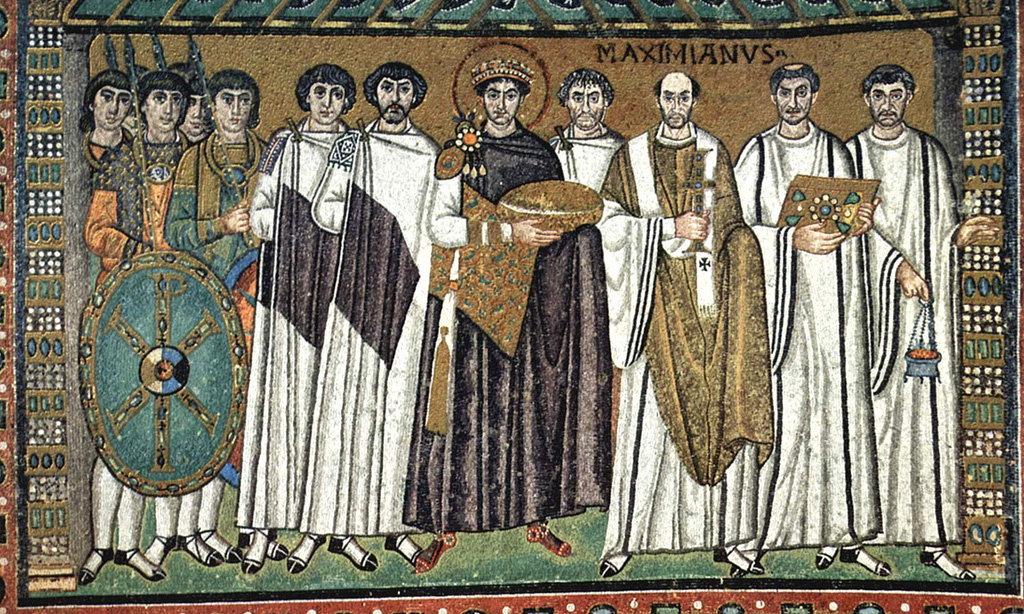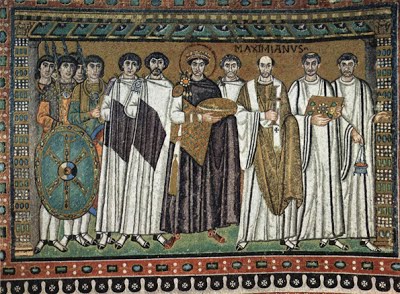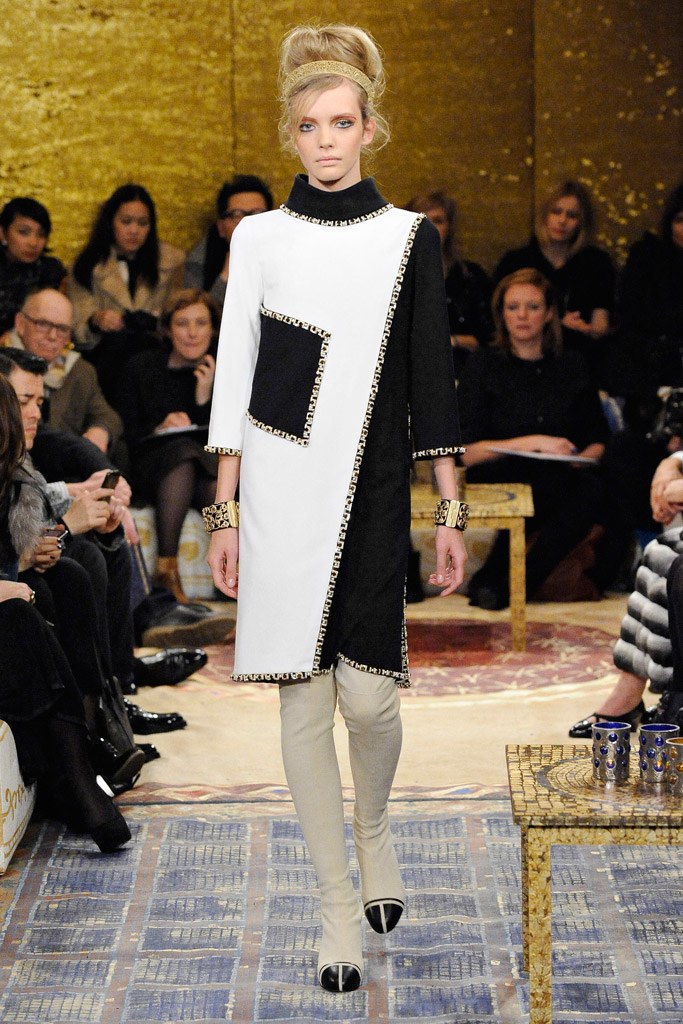A rectangular panel, often ornamented with embroidery or jewels, attached to the front of a cloak. Worn as a sign of status by Byzantine emperors and other important officials.
The Details
T
he Dictionary of Costume (1969) by R. Turner Wilcox defines the tablion while explaining its origins, writing:
“The roman toga gradually evolved into the full-length semicircular mantle worn by the Church and Byzantine emperors. The tablions with which it was ornamented were twelve-inch squares solidly embroidered in gold and colored silk thread and accented with varicolored jewels and pearls. The squares were placed at the front corners of the semicircular cloak and at the edge in center back.” (339)
The mosaic of Emperor Justinian and his retinue, ca 547 CE, from the Basilica of San Vitale in Ravenna, Italy features Justinian with a golden tablion adorning his purple chlamys with two attendants with purple tablions (Fig. 1).
According to 20,000 Years of Fashion, the tablion was:
“a rectangular piece of cloth inset in the front of the chlamys at the waist height; it appeared in costumes of both emperors and empresses and in the dress of the high court dignitaries during the Byzantine empire.” (Boucher 74)
Empress Ariane is shown wearing a tablion in a 6th century ivory carving in the Bargello museum in Florence (Fig. 2). Mary Houston in Ancient Greek, Roman, and Byzantine Costume and Decoration (1931) writes that the tablion:
“was an important feature of men’s court dress from the fifth to the tenth century, and even later. On it was lavished the most sumptuous decoration of the whole costume. As a rule, it was a cloth of gold embroidered in jewels. The Empress wore it also from the eighth to the eleventh century, but otherwise it was confined to the Emperor and his nobles.” (136)
The Met describes the dress of King Saul, which features a tablion, in a 7th century silver plate (Fig. 3):
“Saul is dressed as member of the Byzantine court. His chlamys, or cloak, worn over a long-sleeved tunic, is fastened with a cruciform fibula, or brooch, the sign of a high-ranking state official (fig 8). The chlamys is adorned with a tablion, a rectangular embroidered panel indicating the wearer’s rank.”
The tablion was one of the most prized parts of a garment due to its lavish embroidering. Embroiderers would ornament these favored geometric panels with silk or gold thread, and favored the use of jewels and bright colors.
Fashion, Costume, and Culture: Clothing, Headwear, Body Decorations, and Footwear through the Ages describes the embroidery work the tablion made so prominent:
“Embroiderers used many rich and colorful types of thread to make their work stand out. They might use silk or gold thread, and they favored bright colors, especially purples, golds, reds, blues, and yellows. The rich and beautiful nature of so much Byzantine clothing owes much to the art of the embroiderer. Byzantine embroidery was a great influence on the embroidery of clothing throughout the Middle Ages (c. 500–c. 1500 C.E.) and beyond in Europe and Russia in particular.”
An example of a golden tablion can be seen in Figure 4, a mosaic from the Church of the Holy Saviour in Chora.
Fig. 1 - Artist unknown. The mosaic of Emperor Justinian and his retinue, 526-547. Mosaic. Ravenna, Italy: San Vitale Basilica. Source: Ravenna-san-vitale
Fig. 2 - Artist unknown. Empress Ariane, 6th century. Ivory. Florence: Musee National Du Bargello. Source: Musée National Du Bargello
Fig. 3 - Artist unknown. Plate with the Presentation of David to Saul, 629–630. Silver; (10 11/16 x 1 9/16in). New York: The Metropolitan Museum of Art, 17.190.397. Gift of J. Pierpont Morgan, 1917. Source: The Metropolitan Museum of Art
Fig. 4 - Artist unknown. Mosaic from the Church of the Holy Saviour, 1077-1321. Mosaic. Chora: Church of the Holy Saviour. Source: Pinterest
Its Afterlife
Chanel’s pre-fall 2011 collection was inspired by the Byzantine opulence and can see the modern take of the tablion (Fig. 6), taking direct inspiration from the Justinian mosaic (Fig. 1).
Fig. 6 - CHANEL. Chanel Pre-Fall, 2011 Collection. Source: Vogue.com
References:
- Boucher, François. 20,000 Years of Fashion: The History of Costume and Personal Adornment. Expanded ed. New York: H.N. Abrams, 1987. http://www.worldcat.org/oclc/777323433.
- Cumming, Valerie, C. Willett Cunnington, Phillis Cunnington, Charles Relly Beard, and C. Willett Cunnington. The Dictionary of Fashion History. Oxford ; New York: Berg, 2010. http://www.worldcat.org/oclc/1011105549.
- Gale, Group. Fashion, Costume, and Culture: Clothing, Headwear, Body Decorations, and Footwear Through the Ages. Edited by Drew D. Johnson, Sara Pendergast, and Tom Pendergast. 2nd ed. Gale Virtual Reference Library. Detroit: UXL, 2013. http://www.worldcat.org/oclc/907119374.
- Houston, Mary Galway, and Mary G. Houston. Ancient Greek, Roman and Byzantine Costume and Decoration: Including Cretan Costume. A Technical History of Costume, v. 2. London: A. & C. Black, 1931. http://www.worldcat.org/oclc/470644561.
- “Plate with the Presentation of David to Saul | Byzantine | The Met.” The Metropolitan Museum of Art, i.e. The Met Museum. Accessed December 28, 2017. https://www.metmuseum.org/art/collection/search/464378.
- Wilcox, R. Turner. The Dictionary of Costume. 1st Macmillan Hudson River ed. New York: Macmillan, 1987. http://www.worldcat.org/oclc/925659137.















